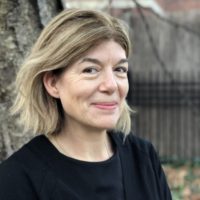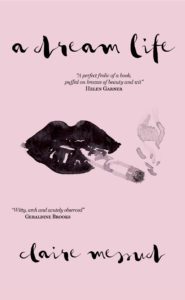“The American family rented the house without having seen it—how could they have, halfway around the world?—so they did not know what it meant.” So begins A Dream Life, out this January from Tablo Tales, a slim, wise novel written by Claire Messud some twenty years before its publication. The story bears many of the themes and structures of Messud’s later work, consistently asking a question central to all of us: What makes home?
In A Dream Life, the modest, charismatic Alice, a woman with a restless, questioning inner life moves halfway around the world, children in tow, to support her husband, positioned overseas. Alice finds herself trying to articulate something important to herself and others within an old house snared by complex and unseen webs. Class issues lead to increasingly heated tension, each character rebelling against confinement within others’ conceptions of their autonomy, moments of discreet or bold self-declaration alive on every page.
Claire Messud is the author of When the World Was Steady, nominated for the PEN/Faulkner Award; The Last Life, The Hunters, and The Emperor’s Children, written while Messud was a fellow at the Radcliffe Institute for Advanced Study. Her novel The Burning Girl was named one of the best books of 2017 by the Los Angeles Times, San Francisco Chronicle, Financial Times, and others outlets. Motivated by deep metaphysical questions, much of her work explores the question of interiority, female or other, and its dance within great sociohistorical constraint. She currently teaches creative writing at Hunter College and is working on a new novel.
Messud and I exchanged a series of emails, our conversation spanning writing, childhood, the play of perspective, a writerly commitment to authenticity, and the joys of rediscovering influence.
***
The Rumpus: What was the genesis of this book? A first spark? Did you have a particular set of aesthetic lodestars?
Claire Messud: I wrote A Dream Life—which for a long time had a different title—over twenty years ago. I wrote it at the same time as the two novellas that are in The Hunters, and they were to be a triptych about displacement, but I never showed this manuscript to my agent or editor. It’s a long story, but basically I put it in a drawer. The spark for the narrative was my own childhood. We moved to Sydney when I was four, and my parents somehow rented a mansion. We didn’t stay there very long.
Writing the story, I was trying to imagine what it had been like for my mother. In those days, the early seventies, wives mostly went along with their husbands; that’s what was expected of them. You didn’t have a choice. For my Canadian mother, Australia seemed very, very far away. At that time, it took almost twenty-four hours of travel to get there.
We forget now, but phone calls home were muffled by static and prohibitively expensive. She was lonely, and my sister and I were small. My dad traveled all the time for work, and when he was home they had to entertain a great deal. I wanted to imagine what all that was like. Alice Armstrong is a fictional character—she’s not my mother—but the set-up is drawn from life.
As for the aesthetic lodestars, one of the other pieces I wrote in the triptych, A Simple Tale, is a homage to Flaubert; but this was written with the beloved ghost of Katherine Mansfield on my shoulder. Among others, I’m sure. And doubtless, too, with an echo of the children’s books I so loved – I gave the house a green baize door in honor of Victorian British children’s novels, in which the green baize door is the demarcation line between the service part of the house and the public rooms. I’ve never actually seen one, though, to my knowledge.
Rumpus: What was your childhood relation to the length of books?
Messud: I don’t think I thought too much about it when I was a child; though I so loved reading that I loved longer books because you could live in them, be with the characters for more time, more story. I was keen on novel series too—Enid Blyton’s Famous Five; C.S. Lewis, of course; The Lion, the Witch and the Wardrobe and its sequels; E. Nesbit’s The Five Children and It and The Phoenix and the Carpet, etc.; and Arthur Ransome’s Swallows and Amazons series—you get the idea. All British, let it be said—I had an Australian childhood, you see. I also loved Ivan Southall’s books, and a book called Seven Little Australians by Ethel Turner, set in the 1890s – in fact, most of my childhood reading was set in worlds long gone by the 1970s.
When I was nine and a half, we moved to Canada, where I threw myself into Nancy Drew—remember The Bungalow Mystery? Or The Secret of the Old Clock? I read Anne of Green Gables, and all of them cast me back in time a good distance. They’re set at the beginning of the twentieth century, and the original Nancy Drew books were written in the 1930s.
I recently reread a book I loved as kid called Henrietta’s House, by Elizabeth Goudge. In it, everyone is horrified because a young couple have bought a novel conveyance called a motor car, and the couple finds the car so noisy and disruptive compared to traveling by horse-drawn carriage that they abandon it by the roadside. I was probably reading this around the time of the gas crisis in the mid-seventies— living in the past, even as a kid.
Rumpus: Such a fine evocation of the way childhood books appear as aleatory yet overdetermined landmarks! Take this any direction you wish: I am thinking of Hawthorne’s The Scarlet Letter and wonder what you think about the gift which writing a novel set in the past lends the writer, a means of being clear-sighted about our current (or future) moment.
Messud: I certainly think that fiction set in the past can be—almost has to be—relevant to the current or future moment. Especially as I get older, I’m aware of “plus ça change . . .” of the patterns of human behavior that repeat endlessly on both the individual and societal levels. Each generation thinks we’re new, that we’re experiencing things never known before—and technological advances, of course, encourage this myth—but in truth, of course, we have much to learn from our predecessors. There’s a riveting Paul Valéry essay from the mid-thirties called “Le Bilan de l’Intelligence” which is remarkably relevant now—precisely about the perils of ignoring the past. Look where that got people in the thirties.
Rumpus: One of the great pleasures in A Dream Life is its flow. The reader moves smoothly through various realms of intimacy and class-based code-switching. Are there any writers you particularly admire for their gifts in perspective?
Messud: Henry Green—I’m in awe of his mastery of individual idioms. Historically, fiction offers a pantheon of writers with an attention to competing perspectives—think of George Eliot, of course, or Tolstoy, or Chekhov; even in “The Dead,” Joyce manages to enter the minds and language not just of Gabriel but, fleetingly or in dialogue, of many of the other characters.
I love the tradition of British women writers whose fictions are born of this capacity—among them, Barbara Pym, Muriel Spark, Penelope Fitzgerald—but perhaps the contemporary ideal, for me, is Alice Munro. I could go on and on. I realize I’m listing authors whose work is based in character. If you’re interested in character, then you’re interested in perspective, and intimacy, and in the distinctions—and distance—between one person’s mind and another’s.
Rumpus: How would you name the themes that weave together your work? Your characters withstand the brunt of the most pernicious and invisible forms of oppression, whether rising from gender, class, age, or nation. Which perspective(s) have been the most challenging or pleasurable for you to write?
Messud: Of course, I’m interested, above all, in people. I deeply love language, and its music, and the sentence, the elastic capacities of which enthrall me every time I sit down to write. But when I have to articulate the heart of my desire to write, I say this: My hope is to illuminate some small element of what it’s like to be a human being alive on this planet.
Which sounds broad—thank goodness—but is also staking a claim against fakery and falsehood, against escapism and the arbitrarily plot-driven. It suggests a faith that there is such a thing, albeit vast, as ‘human experience,’ and such a thing as “reality,” however differently that is experienced by individuals; and it expresses the faith that some elements thereof can in some measure, however partially, be articulated in language and communicated—across space and time and cultures. It’s also a statement of faith in the imagination, which gets short shrift at present.
Life is damage. Isn’t this true? An infant is born in its unique, idiosyncratic perfection, trailing clouds of glory, as Wordsworth put it, and life will batter like a relentless storm against that perfect being. The encounter between an individual consciousness and life itself is a site of amazing courage and transcendence, of joy and inspiration, and also of injury and grief, of despair. It’s endlessly diverse and endlessly the same – like watching the ocean.
If you’re interested in people, in what individual people are like, then you’re always curious, and every person’s story fascinates. Two people will undergo the exact same experience and yet take away radically different things.
All a long way of saying that if you attend to each character, you never find them dull; and their struggles are always simultaneously large and potentially meaningful, and small and animal. It’s key to remember the small and animal.
When my niece was about three or four, we’d been visiting her family and were heading for the train station to return home. We stopped to buy sandwiches to eat on the journey; and outside the deli, my niece started to bawl. I squatted down and gave her a hug, and stroked her hair: “Are you sad that we’re leaving?” I asked, all gentle tenderness. “No,” she replied through her tears. “I want a sandwich.” That’s life.
I haven’t answered the question because I can’t, really. I’m interested in everyone – or rather, I’m interested in anyone. I’m interested in life.
Rumpus: One of the remarkable aspects about every one of your novels is the elegance of your lingering after-questions, the mystery in your asymmetrical double portraits and plots. Is this any way to live, the suppressed voice asks, a haunting final metaphysical question. I wonder if this form, a kind of fictive volta, is in any way conscious?
Messud: Again, I’m not sure I can answer properly. Writing fiction is to me like a symphony – you’re hearing it in your head. You’re in it; you’re a vehicle. You are, as Bernhard would have it in The Loser, the piano. You’re not analyzing it. You’re trying to transmit an experience, as richly and with as much honest complexity as you possibly can.
The question of “How then must we live?” is surely behind every story. Of course, what are the consequences of how we have lived, or are living? I don’t believe it’s our job as writers to answer these questions; it’s our job to raise them.
***
Author photo credit by Lucian Wood





